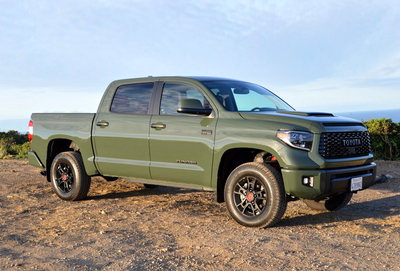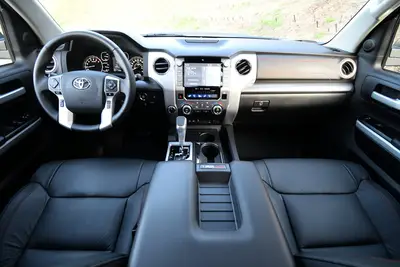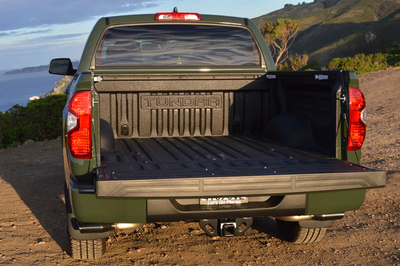2020 Toyota Tundra TRD Pro Crewmax Review by David Colman +VIDEO
Impressive, but stepping up to it requires a step up
By David Colman
Special Correspondent to THE AUTO CHANNEL
The TRD PRO Tundra's cab floor sits so high off the ground (2 feet) that most drivers need help climbing in and out. But our test Tundra offered no such help, either in the form of a running board or a driver's side grab handle. So mounting and dismounting became a sort of gymnastic exercise, requiring you to haul yourself into place by grabbing the steering wheel while swinging your butt in a wide arc. Exit demanded a freefall plunge where you hoped to stick the landing or else. Six footers won't have this problem but shorter folks need a step ladder or an optional running board.
Once emplaced inside the turret of our military green test behemoth, the driver is delighted by a number of antiquated features that have recently disappeared from the automotive landscape. Like real gauges to monitor important mechanical functions. Or big fat, knurled knobs to control HVAC activity, rather than tablet menu mania. Under your nose sits a quartet of pointer equipped gauges tracking water temp, oil temp, battery charge (voltmeter) and fuel level. Display of these critical parameters has all but vanished from today's video arcade dash displays. Likewise, it was a pleasure to use fat knobs to adjust fan output, temperature range, and airflow position without resorting to a cell phone tablet maze.
The one gauge you'll definitely want to keep a sharp eye on is that fuel gauge. Although the TRD PRO Tundra is fitted with a 38 gallon tank, its 5.7 liter V8 sucks a gallon every 14 miles on average, so a full tank is good for about 500 miles before you'll need a $140 fill up. With a 381hp engine producing 401lb.-ft. of torque, the TRD PRO's I-Force engine is more than capable of squirting through holes in traffic with ease, despite the truck's three ton curb weight. Not only is the TRD PRO quick, but also endowed with a pleasantly healthy exhaust burble thanks to its TRD Dual Exhaust system.
This 3UR-FE power unit drives a six speed sequential shift automatic transmission. Toyota supplies part-time or full time 4 Wheel Drive, with selection governed by yet another fat knurled knob prominently located on the face of the dash next to the steering wheel. During our week with this truck, it rained heavily on occasion. We were able to compare performance in 2WD mode to operation with 4WD engaged. On slick roads, in 2WD, the rear tires were limited in adhesion, and began to chatter if too much torque was applied from a standing start. After switching over to 4WD on the fly, we were astounded by the improvement in traction. The truck hooked up so fast it felt like a completely different vehicle than it had in 2WD mode. The Tundra simply squatted, lifted its front end like a speed boat, and disappeared down the road like a top fuel dragster.
Assisting in this performance were the TRD PRO's suspension and wheel/tire refinements. At each corner sits an 18x8J BBS forged alloy rim fitted with a 275/65R18 Michelin LTX A/T (TW 500) radial that leaves a suitably massive print on the pavement. Toyota fits the TRD PRO with a fine tuned set of TRD Fox shock absorbers with remote fluid reservoirs and 3-stage compression damping. The high (65 aspect ratio) tires and specifically tuned Fox shocks give this Tundra an authoritative stance and a well snubbed ride quality. But make no mistake about overestimating its agility, because this huge Tundra is a beast to wrestle in tight quarters. Visibility to the corners is severely limited from your perch in the cab, so you need to be very careful about backing and parking maneuvers. Inching this Tundra into position is the key to keeping its flanks dent free.
The entire TRD PRO series of trucks share commonality of seat design. This is unfortunate because the chosen standard seat is unsupportive and uncomfortably hard. But it does at least look good, with black leather trimming and red contrast stitching. Our test Tundra included a $579 Spray-On Bedliner which protects the sheet metal but looks rather ratty after transport of dirty items. We especially liked the standard alloy bed rail tie down stanchions, the slow drop tailgate, and the sliding rear cab window (which could use a wiper in heavy rain).
If you are buying this Tundra to tow, you will appreciate the thoughtful list of standard inclusions: receiver hitch, 4.30:1 rear axle ratio, engine and transmission fluid coolers, Tow/Haul mode button, heavy duty battery and alternator, 4/7 pin electrical connector, and last but not least, that 38 gallon fuel tank. For heavy duty towing, industrial grade construction use, or flat-out Baja running, it's tough to beat the TRD PRO Tundra for the money.
2020 TOYOTA TUNDRA TRD PRO CREWMAX
ENGINE: 5.7 liter I-Force V8, 32V DOHC with Dual Independent VVT-i
HORSEPOWER: 381hp
TORQUE: 401lb.-ft.
FUEL CONSUMPTION: 13MPG City/17MPG Highway
PRICE AS TESTED: $55,947
HYPES: Full Time Beast Mode
GRIPES: Pancake Seats, Invisible Corners
STAR RATING: 9 Stars out of 10








